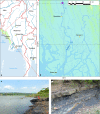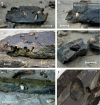Discovery of a silicate rock-boring organism and macrobioerosion in fresh water
- PMID: 30038289
- PMCID: PMC6056532
- DOI: 10.1038/s41467-018-05133-4
Discovery of a silicate rock-boring organism and macrobioerosion in fresh water
Abstract
Macrobioerosion is a common process in marine ecosystems. Many types of rock-boring organisms break down hard substrates, particularly carbonate rocks and calcareous structures such as dead corals and shells. In paleontology, the presence of rocks with boreholes and fossil macroboring assemblage members is one of the primary diagnostic features of shallow marine paleo-environments. Here we describe a silicate rock-boring organism and an associated community in submerged siltstone rock outcrops in Kaladan River, Myanmar. The rock-boring mussel Lignopholas fluminalis is a close relative of the marine piddocks, and its borings belong to the ichnospecies Gastrochaenolites anauchen. The neotectonic uplift of the area leading to gradual decrease of the sea level with subsequent shift from estuarine to freshwater environment was the most likely driver for the origin of this community. Our findings highlight that rocks with macroborings are not an exclusive indicator of marine paleo-ecosystems, but may also reflect freshwater habitats.
Conflict of interest statement
The authors declare no competing interests.
Figures





References
-
- Cáceres LM, Muñiz F, Rodríguez-Vidal J, Vargas JM, Donaire T. Marine bioerosion in rocks of the prehistoric tholos of La Pastora (Valencina de la Concepción, Seville, Spain): archaeological and palaeoenvironmental implications. J. Archaeol. Sci. 2014;41:435–446. doi: 10.1016/j.jas.2013.09.001. - DOI
-
- Warme, J. E. in The Study Of Trace Fossils (ed Frey, R. W.) 181–227 (Springer, Berlin Heidelberg, 1975).
-
- Pinn EH, Thompson RC, Hawkins SJ. Piddocks (Mollusca: Bivalvia: Pholadidae) increase topographical complexity and species diversity in the intertidal. Mar. Ecol. Prog. Ser. 2008;355:173–182. doi: 10.3354/meps07248. - DOI
-
- Naylor LA, Coombes MA, Viles HA. Reconceptualising the role of organisms in the erosion of rock coasts: a new model. Geomorphology. 2012;157:17–30. doi: 10.1016/j.geomorph.2011.07.015. - DOI
-
- Moura, D. et al. Integrated assessment of bioerosion, biocover and downwearing rates of carbonate rock shore platforms in southern Portugal. Cont. Shelf Res.38, 79–88 (2012).
Publication types
MeSH terms
Substances
LinkOut - more resources
Full Text Sources
Other Literature Sources
Molecular Biology Databases

